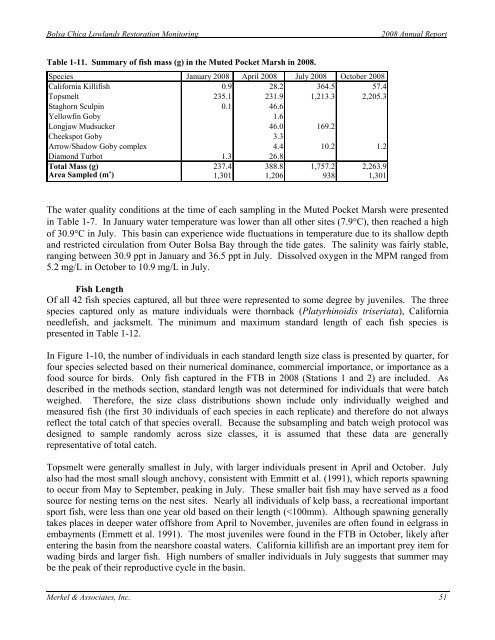2008 Annual Monitoring Report (pdf 10.9MB) - Bolsa Chica ...
2008 Annual Monitoring Report (pdf 10.9MB) - Bolsa Chica ...
2008 Annual Monitoring Report (pdf 10.9MB) - Bolsa Chica ...
You also want an ePaper? Increase the reach of your titles
YUMPU automatically turns print PDFs into web optimized ePapers that Google loves.
<strong>Bolsa</strong> <strong>Chica</strong> Lowlands Restoration <strong>Monitoring</strong><br />
<strong>2008</strong> <strong>Annual</strong> <strong>Report</strong><br />
Table 1-11. Summary of fish mass (g) in the Muted Pocket Marsh in <strong>2008</strong>.<br />
Species January <strong>2008</strong> April <strong>2008</strong> July <strong>2008</strong> October <strong>2008</strong><br />
California Killifish 0.9 28.2 364.5 57.4<br />
Topsmelt 235.1 231.9 1,213.3 2,205.3<br />
Staghorn Sculpin 0.1 46.6<br />
Yellowfin Goby 1.6<br />
Longjaw Mudsucker 46.0 169.2<br />
Cheekspot Goby 3.3<br />
Arrow/Shadow Goby complex 4.4 10.2 1.2<br />
Diamond Turbot 1.3 26.8<br />
Total Mass (g) 237.4 388.8 1,757.2 2,263.9<br />
Area Sampled (m 2 ) 1,301 1,206 938 1,301<br />
The water quality conditions at the time of each sampling in the Muted Pocket Marsh were presented<br />
in Table 1-7. In January water temperature was lower than all other sites (7.9°C), then reached a high<br />
of 30.9°C in July. This basin can experience wide fluctuations in temperature due to its shallow depth<br />
and restricted circulation from Outer <strong>Bolsa</strong> Bay through the tide gates. The salinity was fairly stable,<br />
ranging between 30.9 ppt in January and 36.5 ppt in July. Dissolved oxygen in the MPM ranged from<br />
5.2 mg/L in October to 10.9 mg/L in July.<br />
Fish Length<br />
Of all 42 fish species captured, all but three were represented to some degree by juveniles. The three<br />
species captured only as mature individuals were thornback (Platyrhinoidis triseriata), California<br />
needlefish, and jacksmelt. The minimum and maximum standard length of each fish species is<br />
presented in Table 1-12.<br />
In Figure 1-10, the number of individuals in each standard length size class is presented by quarter, for<br />
four species selected based on their numerical dominance, commercial importance, or importance as a<br />
food source for birds. Only fish captured in the FTB in <strong>2008</strong> (Stations 1 and 2) are included. As<br />
described in the methods section, standard length was not determined for individuals that were batch<br />
weighed. Therefore, the size class distributions shown include only individually weighed and<br />
measured fish (the first 30 individuals of each species in each replicate) and therefore do not always<br />
reflect the total catch of that species overall. Because the subsampling and batch weigh protocol was<br />
designed to sample randomly across size classes, it is assumed that these data are generally<br />
representative of total catch.<br />
Topsmelt were generally smallest in July, with larger individuals present in April and October. July<br />
also had the most small slough anchovy, consistent with Emmitt et al. (1991), which reports spawning<br />
to occur from May to September, peaking in July. These smaller bait fish may have served as a food<br />
source for nesting terns on the nest sites. Nearly all individuals of kelp bass, a recreational important<br />
sport fish, were less than one year old based on their length (






